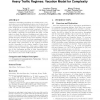117
Voted
MOBIHOC
2009
ACM
16 years 1 months ago
2009
ACM
In this paper, we present a Gaussian mixture model based approach to capture the spatial characteristics of any target signal in a sensor network, and further propose a temporally...
76
Voted
MOBIHOC
2009
ACM
16 years 1 months ago
2009
ACM
In this paper, we consider a non-saturated IEEE 802.11 based wireless network. We use a three-way fixed point to model the node behavior with Bernoulli packet arrivals and determi...
90
Voted
MOBIHOC
2009
ACM
16 years 1 months ago
2009
ACM
We consider a high density of sensors randomly placed in a geographical area for event monitoring. The monitoring regions of the sensors may have significant overlap, and a subset...
99
Voted
MOBIHOC
2009
ACM
16 years 1 months ago
2009
ACM
Most future large-scale sensor networks are expected to follow a two-tier architecture which consists of resource-rich master nodes at the upper tier and resource-poor sensor node...
112
Voted
MOBIHOC
2009
ACM
16 years 1 months ago
2009
ACM
Node mobility and end-to-end disconnections in Delay Tolerant Networks (DTNs) greatly impair the effectiveness of data dissemination. Although social-based approaches can be used ...
90
Voted
MOBIHOC
2009
ACM
16 years 1 months ago
2009
ACM
Routing is one of the most challenging open problems in disruption-tolerant networks (DTNs) because of the shortlived wireless connectivity environment. To deal with this issue, r...
97
Voted
MOBIHOC
2009
ACM
16 years 1 months ago
2009
ACM
In this paper, we propose a practical scheme, called Non-Binary Joint Network-Channel Decoding (NB-JNCD) for reliable communication in wireless networks. It seamlessly couples cha...
79
Voted
MOBIHOC
2009
ACM
16 years 1 months ago
2009
ACM
Due to its low complexity, Greedy Maximal Scheduling (GMS), also known as Longest Queue First (LQF), has been studied extensively for wireless networks. However, GMS can result in...
MOBIHOC
2009
ACM
16 years 1 months ago
2009
ACM
Sectorized antennas can increase wireless network capacity through greater spatial reuse. Despite their increasing popularity, their real-world performance characteristics in dens...
MOBIHOC
2009
ACM
16 years 1 months ago
2009
ACM
Distributed scheduling algorithms for wireless ad hoc networks have received substantial attention over the last decade. The complexity levels of these algorithms span a wide spec...






